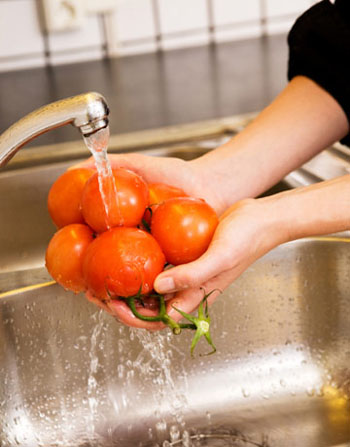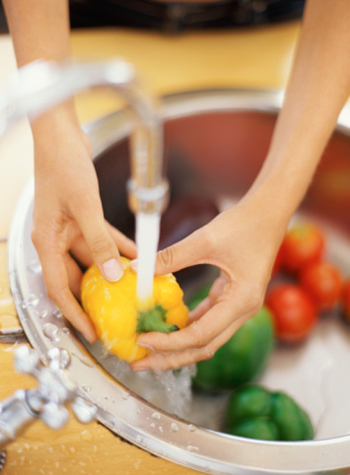| Share |  |
 | |||
Healthy Cooking and Food Care Tips: Washing Fruits and Vegetables
 No matter how clean and attractive a display of grocery store produce may appear, it's impossible to tell what trace amounts of bacteria, pesticide residue or just plain dirt and grime may still remain after it has been harvested, handled, stored, packaged and shipped. Though it may be impossible to eliminate all pesticide residues from fruits and vegetables, it is still vital to wash them carefully to reduce pesticide consumption as much as possible and to avoid food borne illness from bacteria.
No matter how clean and attractive a display of grocery store produce may appear, it's impossible to tell what trace amounts of bacteria, pesticide residue or just plain dirt and grime may still remain after it has been harvested, handled, stored, packaged and shipped. Though it may be impossible to eliminate all pesticide residues from fruits and vegetables, it is still vital to wash them carefully to reduce pesticide consumption as much as possible and to avoid food borne illness from bacteria.
While most produce items may not exceed safety tolerances for a dose of a single pesticide, many contain multiple pesticide residues that can reach (add up to) toxic levels. Another factor to consider is that greater amounts of produce are being imported from other countries containing on average three times the pesticide residue levels found on domestically produced food. Even when produce is washed after picking, pesticide residue may still exist since petroleum based agricultural chemicals are made to be somewhat "waterproof" so as not to be washed off by rain and irrigation.
Some fruits and vegetables are safer than others when it comes to pesticide residues. A report by the Environmental Working Group, using data from the U.S. Food and Drug Administration, found many of the health risks associated with pesticides are concentrated in a limited number of fruits and vegetables. Examples of more heavily contaminated produce items are apples, peaches, bell peppers, imported grapes, celery, spinach, strawberries, raspberries and potatoes. Some of the least contaminated include avocados, onions, scallions, corn, cauliflower, cabbage, broccoli, green peas, carrots, sweet potatoes, and blueberries. For a complete list of pesticide amounts in fruits and vegetables tested by the EWG, go to this link: http://foodnews.org/fulldataset.php
 Another consideration with regard to washing fresh produce is the waxy coating applied to make produce look nice and shiny in the grocery store. Many fruits and vegetables, particularly those with high moisture content, lose their natural waxy coating in the washing process that occurs after harvest. They are often coated with things such as food grade shellac or carnauba wax to enhance appearance as well as to seal in moisture and extend storage life. Though the claim is made that the waxy substances meet FDA food additive regulations and are safe for consumption, others sources say the coating facilitates retention of pesticides and fungicides sprayed on the produce prior to waxing, making them difficult to scrub off. One solution to this dilemma is to purchase local produce, which does not require lengthy preservation. Another is to peel produce before consumption though some valuable nutrients will be loss in that process. Certainly, the best solution for avoiding both waxy coating and pesticide residue is to buy organic fruits and vegetables, though higher cost and lack of availability do not always make that option feasible for everyone. Prioritize your spending on those produce items your family eats most often and ones that contain the greatest levels of pesticide residue.
Another consideration with regard to washing fresh produce is the waxy coating applied to make produce look nice and shiny in the grocery store. Many fruits and vegetables, particularly those with high moisture content, lose their natural waxy coating in the washing process that occurs after harvest. They are often coated with things such as food grade shellac or carnauba wax to enhance appearance as well as to seal in moisture and extend storage life. Though the claim is made that the waxy substances meet FDA food additive regulations and are safe for consumption, others sources say the coating facilitates retention of pesticides and fungicides sprayed on the produce prior to waxing, making them difficult to scrub off. One solution to this dilemma is to purchase local produce, which does not require lengthy preservation. Another is to peel produce before consumption though some valuable nutrients will be loss in that process. Certainly, the best solution for avoiding both waxy coating and pesticide residue is to buy organic fruits and vegetables, though higher cost and lack of availability do not always make that option feasible for everyone. Prioritize your spending on those produce items your family eats most often and ones that contain the greatest levels of pesticide residue.
Though no washing method completely removes or kills all bacteria or pesticide residues, fruit and vegetable sprays are available that contain surfactants which cut through wax, oils, dirt, pesticide and bacterial residues more effectively than water alone. Surfactants are cleaning agents that break the electrostatic attractions between residues and the surface of the vegetable or fruit, creating a lifting action that loosens and dissolves water-resistant substances for quick removal. These sprays are non-toxic and biodegradable and are available in health food stores as well as many grocery stores. For firm produce, such as apples or peppers, simply spray thoroughly, rub with your hands for 20 to 30 seconds and then rinse thoroughly with water before eating. For softer or less easily handled produce, use a diluted mixture of water and vegetable cleaning spray and simply dip, agitate and rinse the produce using a colander. Another method recommended to remove pesticides and microbes from fruits and vegetables is to add one tablespoon of 35% food grade hydrogen peroxide (available online or in health food stores) to a sink half-filled with water. Soak produce for five to fifteen minutes and rinse thoroughly with fresh water. Soak produce with thin peels and leafy vegetables a shorter period of time and thicker vegetables, such as carrots, a longer period of time.
Always choose healthy looking, ripe fruits and vegetables when you shop. Avoid bruised, moldy and mushy produce. Handle produce gently at the store - avoid putting other groceries on top of produce in the cart to protect from bruising. Keep fresh greens, fruits and vegetables away from uncooked meats to avoid cross-contamination. Wash all parts of your fruits and vegetables, even if you don't plan on eating them, as bacteria can be transferred from the outside of the fruit or vegetable to the knife you use to cut them and then onto the consumed portion.
Here are some basic guidelines for washing fruits and vegetables:
- Wash produce just before consuming it as it will spoil faster when washed prior to storage.
- Don't use any soaps, detergents, bleaches or other toxic cleaning chemicals which could leave their own harmful residue on the produce. Fruits and vegetables are porous and can absorb detergent or bleaches not intended for use on foods.
- Begin with clean hands. Wash your hands for 20 seconds with warm water and soap before and after preparing fresh produce.
- Clean all surfaces and utensils with soap and hot water, including cutting boards, peelers, counter tops, knives and dishes that will touch fresh produce.
- Cut away any damaged or bruised areas on fresh fruits and vegetables before preparing and/or eating, discarding any portions that appear rotten.
- Discard the outer leaves of leafy vegetables such as lettuce and cabbage before washing since they grow close to the ground where soil can be tainted. Separate leaves, and then rub each leaf while rinsing.
- Use a salad spinner to wash and dry lettuce or leafy greens if you have one - otherwise, use a colander and then dry greens with paper towels.
- Under clean, running water, rub fruits and vegetables briskly with your hands to remove dirt and surface microorganisms - spray first with biodegradable cleanser if desired.
- Place berry fruits and grapes in a colander and either spray with a kitchen sink sprayer or move basket quickly in and out of a 5-8 quart pot of warm water with cleaning solution.
- For the other fruits and vegetables, use a soft brush to scrub the food with the solution for five to ten seconds, then rinse again with slightly warm water.
- After washing, dry any produce that will not be eaten or cooked right away with paper towels or a clean tea towel as moisture left on produce may promote survival and growth of microorganisms.
Copyright © 2008-2015 Lucinda Bedogne, CNHP, CNC
Post Your Comment...
|
|
||||||||||||


